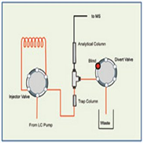Find methods for your needs
Refine by Feature
Displaying 1-5 of 5 results for Tag: LC
AN360: Rapid Determination of Azo Dyes in Textiles Using ASE and HPLC with MS and UV Detection
Instrument Type: HPLCAzo dyes are used widely in the manufacture of various consumer goods such as leather, textiles, plastics, paper, hair care products, and cosmetics. The EU enacted European Parliament Directive 2006/61/EC, prohibiting the manufacture and sale of consumer goods containing certain aromatic amines originating from specific azo dyes. This application note describes methods for extraction of textile samples using ASE, along with the analytical methods for the determination of 22 aromatic amines, some of which are specified in the Parliament Directive.
Non-Targeted Screening of Lipophilic Marine Biotoxins by Liquid Chromatography-High-Resolution Mass Spectrometry
Instrument Type: LCMSMarine biotoxins are produced by naturally occurring microalgae, whose populations can increase significantly under certain environmental conditions to form a harmful algal bloom (HAB). Marine biotoxins pose a significant food safety risk when bioaccumulated in shellfish that are ingested by humans. We describe the use of the Thermo Scientific Exactive benchtop LC/MS system powered by Orbitrap technology for screening lipophilic marine biotoxins commonly found in shellfish. The method was optimized using a standard mixture of marine biotoxins, and then applied to a mussel tissue extract.
Analysis of Early Eluting Pesticides in a C18-Type Column Using a Divert Valve and LC-MS/MS
Instrument Type: LCMSMSMany pesticide analyses are based on the QuEChERS extraction method, which uses acetonitrile (ACN) in the final extraction step. This approach can cause peak shape problems (splitting or broadening) especially for the early eluting analytes. The common practice of exchanging the final extraction solvent step for one similar to the mobile phase is laborious and can lead to analyte losses. We demonstrate the ability to override the solvent effects from a sample extract using gradient solvents with HPLC. Additionally, to increase injection volume without overloading the column.
Determination of Acrolein and Other Process Contaminants in Beer, Wine, and Potato Chip Matrices by Liquid Chromatography-Single Quadrupole Mass Spectrometry
Instrument Type: LCMSMSCarbonyl compounds are widely found in food products. Acrolein is the a,ß-unsaturated carbonyl compound also called prop-2-enal or acrylic aldehyde. Acrolein has a high volatility and very high reactivity.1 To evaluate risk assessment, more information on its occurrence needs to be generated. The aim of this study was to develop an in-house validated method for the determination of a wide range of carbonyl compounds to quantify these process contaminants in beer, wine, and potato chips using LC/MS.
AN106: Ion Chromatography in the Pharmaceutical Industry (Mixed-Mode Column with UV Detection).
Instrument Type: HPLCIon Chromatography is a simple and accurate technique for the analysis and quantification of charged species. This application note describes the use of ion exchange chromatography and ion exclusion chromatography in the pharmaceutical industry for the analysis of ions in ingredients and final products. The topic of cleaning validation is also discussed as it applies to charged species. Here shows the separation of a series of aromatic acids by using an anion exchange column (OmniPac PAX-100) and UV absorbance detection.





